One day she’s a sweet, cuddly little kitten content to stretch out in your lap and doze off with a tender smile on her furry little face. The next day she’s a raging, yowling, relentless beast with an urgency in her eyes you’ve never seen before. Congratulations, you’ve got a teenaged cat!
Is my cat in heat?

First off, cats in heat do not shed the lining of their uterus as many other mammals do. This being the case, your female cat will not be bleeding as an indicator. If she is, you need to see a vet right away. Otherwise, contacting a vet is not necessary. The burden of her heat falls mostly on you.
Incessant yowling is the most obvious, as well as the most nerve-wracking, trait of a female cat in heat. Combine that with excessive grooming (particularly of her hindquarters), and sticking her butt up in the air in a mating position—and it’s looking a bit more like she is, indeed, in estrus. Add to that mood swings, spraying urine, and perhaps a loss of appetite, and you’ve most certainly got a cat in heat.
Why do cats meow when they are in heat?

Cats meow at people when they want something. According to Katenna Jones, Associate Certified Applied Animal Behaviorist, your cat is, “seeking attention from you or asking for help to let you know something is off. She’s confused or uncertain about what is ‘going on’ and why she feels the way she does. She’s asking for help or reassurance.”
In this instance, what she wants is out, and she wants it now. Jones continues that her meowing is “to announce she’s receptive and seeking a mate, as well as announcing to any nearby competitive ladies, that she is in heat and this is her area.”
When your female’s urge to mate is calling, she reacts loudly and continuously.
Cat estrus cycle: the heat cycle
A cat’s first heat can come as early as four months and lasts an average of seven days. Depending on the season, (heat season is January to October, once there are approximately 14 to 16 hours of daylight), your cat may come into heat again every two to three weeks! Not only is this a strain on your cat’s system, but it can also be exasperating for you.
What can I do to keep my cat from meowing excessively when she is in heat?

Showing your cat extra attention by playing with her will tire her out and, hopefully, help her sleep better. Soft music might also soothe her.
“Other than affection and comfort, your best bet with a meowing cat in heat is to just let it happen and spay her so it doesn’t happen again. Petting, snuggling, playing, and lots of brain outlets like Food Puzzles for Cats can help. If you don’t intend to spay your cat, just know this behavior may happen each time she goes into heat, and it is completely normal,” states Jones.
Other remedies
- You may be able to calm your cat temporarily with a bit with catnip, however, not all cats react to it, and some cats become more aggressive with it. Tread lightly.
- Another natural remedy is an amino acid called L-theanine. It may relax your cat, however, it takes time to take effect, and it is not recommended for pregnant or breeding animals.
- Pheromones in a spray bottle or diffuser mimic those secreted from the cat’s scent glands on her face and will help her to feel safe and calm in her environment. It’s worth a try.
- Keep in mind that some cats will prefer to be left alone. If that’s the case, try to keep things as peaceful and quiet as possible for her, and always provide a safe place for her to escape to should she need to hide.
The only permanent solution is to spay her

Considering the stressful nature of the feline estrus cycle—for both of you–the easiest and safest solution is an ovariohysterectomy (OVH), or spay. Most veterinarians will recommend this surgery be done at about 5 months, which is typically before your cat’s first heat.
What does spaying involve?
The surgery is a relatively simple, routine procedure done by appointment in a veterinary hospital. After dropping your cat off first thing in the morning, veterinary staff will prepare her by shaving a small part of her abdomen where the incision will be, anesthetizing her, and inserting a breathing tube. The surgery will take 15 to 20 minutes, and she will wake up shortly after that. Your cat should be able to go home later the same afternoon with some pain medication and an Elizabethan (E) collar. One of her front legs will most likely have a bandage where intravenous (IV) fluids were administered during surgery. You’ll be instructed to keep her calm for seven to ten days, monitor the incision for any signs of infection, and perhaps return to the hospital for suture removal. The average cost to spay a cat is approximately $200 to $300. Shop around for low-cost clinics, and you may save hundreds of dollars.
Extra time = extra cost
Should your cat be in heat during the spay, swollen organs and blood vessels will increase the time spent in surgery, and a relatively small additional charge will probably be added due to that and a slightly increased surgical risk. Obviously, it’s more economical and safer to schedule surgery when your cat is NOT in heat.
Methods that are NOT recommended to calm a cat in heat

A procedure called either ‘mating simulation’ or ‘the Q-tip method’ is NOT recommended by any reputable sources and can be dangerous. The procedure is intended to mimic the act of mating and therefore, trick the female into believing that mating has taken place so she will settle down. Inserting a foreign object (a Q-tip) into your cat’s reproductive tract can both injure her sensitive system and cause an infection.
Other unacceptable tactics include scolding or hitting your cat, ignoring her, changing her routine, and letting her out. Katenna Jones adds, “Never punish her even if it’s annoying or keeping you up at night. Meowing when in heat is not only normal, it’s common. And don’t ignore her as she may be in need of attention, or affection and comfort.”
Can my cat go into heat once she is spayed?
Occasionally, a cat that has been spayed will show signs of being in heat due to the following.
- Ovarian Remnant Syndrome is caused by a small piece of ovarian tissue being left behind after surgery, or the ovarian tissue was missed due to it being located in a part of the cat’s body just outside the surgical area. This unremoved tissue will continue to secrete estrogen and cause heat-like symptoms.
- Pyometra, a uterine infection, can also develop from residual tissue in the abdomen. It will most likely be accompanied by fever, lethargy, or other signs of illness.
- Adrenal Tumors are rare, however, they can produce hormones that trigger heat-like symptoms. These symptoms will be constant rather than cyclical.
- Exposure to hormones can accidentally happen if you or a housemate uses estrogen creams on your hands or arms, or if you forget to wash it off your hands after application elsewhere. All it takes is a friendly lick from your kitty to ingest some of it.
- Lastly, if you’ve adopted or taken in an adult stray, you may have been told, or assumed, the cat was spayed when she really hadn’t been.
See your vet
If your female shows any signs of being in heat after she’s been spayed, it’s imperative to contact your vet. Long-term exposure to female hormones increases the risk of your cat developing mammary cancer. (Thus, another reason for spaying before the first heat!)
FAQ
What is a phantom pregnancy in cats?
A phantom, or false, pregnancy happens when a cat goes into heat and ovulates but does not become pregnant. Her progesterone levels increase and her body is tricked into thinking she is pregnant.
Do male cats go into heat?
Males do not go into heat as what is seen in a female, because a male can mate at any time. To say a male is in ‘heat’ is referring to his awareness and reaction to a female in heat within his smelling or hearing range.
Should I let my cat have one litter?
The common misconception is that one litter will benefit the cat. It is actually just the opposite. Spaying prevents exposure to possible cancer-causing hormones and it is much less risky than pregnancy and birth.


